The following Articles and Images have been added to the database
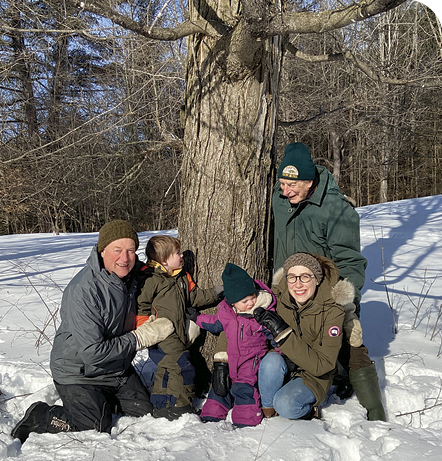
Finally, warmer weather has arrived in February and the first hint of spring is in the air. This signals to us that the maple syrup season is about to begin again, and at Fortune Farms we are busy getting ready to tap the trees.
It is now fifty years since we purchased this maple sugar bush from the McIntosh family and continued their maple syrup operation. Much has changed over that time. A new generation of the family is now in charge, so Ruth and I may now sit back and watch our children, grandchildren and great-grandchildren carry on the family business.
The changes to the sugar bush are so gradual that on a casual walk around the forest it looks much the same as it did in 1972. However, I know that many of the older maple trees that were dominant in 1972 have now been replaced by younger, faster growing trees and that some tree species are missing. Many of the old trees have died, fallen down and decomposed. After fifty years not even the stumps remain.
The sugar bush has withstood many challenges. The trees have suffered from several summers of drought, windstorms, caterpillar and insect infestations, a microburst in 1997 that severely damaged about four acres of mature maple and beech, and most damaging of all, the ice storm of 1998. The ice storm destroyed about sixty percent of the canopy! We were alarmed and concerned for the trees, but trees are resilient and with favourable conditions will recover. Sunlight was allowed to reach the forest floor, which stimulated an immediate regeneration of an understory of maple and other species. The young trees were so thick that we had difficulty moving among them. Over time these young trees “self-thinned” as the weaker ones died. We also completed some judicious thinning. This has resulted in a healthy stand of young trees waiting for their chance to grow through a break in the canopy. We never thought the sugar bush would recover so well.
The number of tree species has changed too, in response to invasive diseases and insects. We have lost our large elms due to Dutch elm disease, our butternut trees due to a canker, our ash trees due to the emerald ash borer, and many of our beech trees due to a bark disease. So far, the maple, pine, basswood, hemlock, oak and cedar trees are growing well. We have done our best to conserve the tree diversity because we know the trees interact through their roots and support each other in times of stress.
Over the years we have learned much about the daily and yearly variation in sap sweetness and flow from our own observations and from the work of research institutes. As a boy, when we used buckets, I knew which tree to visit for a taste of the sweetest sap. We do know that sweetness increases with the size of the crown, but we do not know why some trees produce sweeter sap than others. It seems to be a genetic trait and persists throughout the life of the tree. We do not know why the sap is sweeter on one side of a tree than the other. We do know that sap flow is stimulated by warm days and cold nights, but we do not know why the sap runs continuously for up to three days and nights when there is no sun or frost. We observed that this phenomenon required particular conditions: the temperature at just above freezing, low atmospheric pressure, no wind, and a heavy cloud and possibly mist or fog. This sap bonanza strains the holding capacity of the tanks and means long hours of continuous syrup making. Maybe over the next fifty years we will finally understand all the mysteries of the maple tree.
With all the current interest in carbon sequestration, we have recently come to realize that our sugar bush stores a large quantity of carbon which increases year by year. We have done some calculations and have discovered that our sugar bush is sequestering substantially more carbon dioxide than we are emitting in our process for making maple syrup. It was not a simple calculation. We had to determine the life cycle carbon footprint of not only the fuel, but all the other materials used in making, packaging and distributing our maple syrup, plus the size and rate of growth of all our trees. We believe that we are safe in stating that, in contrast to other sources of sugar, maple sugar has a positive carbon footprint. Perhaps our slogan should be “Use Maple Syrup — Sweet and Carbon-Friendly”.
We are hoping that the rate of Covid-19 infections will continue to decrease and eventually stabilize. We anticipate that most sugar camps will be able to open for visitors this year. There will still be necessary Covid precaution protocols as we all learn to live with this ongoing problem. It is advisable to check the websites before heading out for your visit to a sugar bush.

The Algonquins have lived in harmony with the Ottawa River watershed for thousands of years. When European explorers first arrived, they brought opportunities for trade and alliances, nation to nation. A Royal Proclamation in 1763 by King George III, recognized that Indigenous Peoples were owners of this land, and any expansion of settlement required a treaty. Nevertheless, the government gradually allowed — indeed encouraged — settlers to simply overtake it for their own purposes. Despite the Algonquins’ efforts over two hundred years to establish a treaty with the federal government, this has yet to occur. Today, Algonquins of Ontario are in negotiation with the Ontario and Federal governments to develop a just resolution to this difficult problem.
On March 14 at 7pm, All My Relations <facebook.com/MMAllMyRelations> will host a two-hour webinar <allmyrelations.ticketsplease.ca> with Councillor Dan Kohoko and Cultural Coordinator Kevin Lamarr from the Pikwakanagan First Nations Reserve <algonquinsofpikwakanagan.com> near Eganville. A member of the Algonquin negotiating team, Councillor Kohoko will describe the history and the nature of the Algonquin land claim, as well as the current state of negotiations.
Dan and Kevin also generously agreed to provide some background information to Humm readers by answering the following questions:
Can you give us a brief glimpse at the nature of the Pikwakanagan community and its history? How did the reserve come to be?
Pikwakanagan is one of 10 Algonquin Indian Reserves recognised undern the Indian Act by Canada. It is the only one in Ontario; there are 9 others in Quebec. Pikwakanagan reserve includes approximately 1800 acres located on the south shore of the Bonnechere River where Golden Lake flows out.
The population is approximately 2700. There are 450 members live on the reserve and the balance of the membership is off reserve mainly in Ontario.
We are governed by a Chief and Council, one Chief and six Councillors. The Chief and each Councillor holds program portfolios, which provide services to the members mainly living in Pikwakanagan. Those portfolio areas include General Government, Social Services, Education, Sports and Recreation, Health, Public Works, Lands, Estates and Membership, Natural Resources and Economic Development.
Our Post Secondary Education program is the only program that provides services to members regardless of whether they live on or off reserve.
Under Public Works we provide municipal type of services such as roads, maintenance, waste management, and public buildings maintenance. We have a fire protection services with its own building, trucks and other equipment. We have approximately 110 homes on the reserve, most of which are privately own by members. However the Chief and Council do have a number of rental units available to those members who do not have their own homes.
We have a building for general government administration building which houses all staff and the various programs. Health has its own building which includes the Family Health Team (nurses and nurse practitioners) as well as visiting doctor who is there one day a week.
We have a number of private member-owned retailed outlets providing fuels, tobacco products, as well as some cannabis. There is a Catholic Church named Church of the Nativity of our Lady located in the community. There is one private campsite for cabins, trailers and RVs.
This information provides a glimpse of Pikwakanagan today.
Here in Lanark County and in Ottawa at various gatherings, non-Indigenous people often acknowledge that they are living on unceded, unsurrendered and/or traditional Algonquin territory. What meaning do these lands have for you?
We are currently negotiating with Canada and Ontario for the return of part of the Ottawa River Watershed located in Ontario. This geographical area contains approximately 9 million acres, at least half is still vacant crown land or park land like Algonquin Park.
The occupied crown land is currently owned by the citizens of Ontario/Canada; early on our quest from government to return this land to the Algonquins, our early petitions endorsed the principle that we would not create a further injustice by requesting the return of these privately held lands.
Currently we have reached an Agreement In Principle with Canada and Ontario for the return of approximately 130,000 acres to Algonquin ownership and control. We intend to develop some of these lands for residential purposes as well as commercial economic development.
We do not believe that 130,000 acres represents a just settlement given the original size of our traditional territory at 9 million acres.
Prior to the arrival of settlers in the territory in Canada, our Indian neighbours around us — Cree to the north, Ojibway to the west and Mohawk to the south — all recognized and respected that the Ottawa Valley was Algonquin territory, owned and controlled.
The Ottawa River Watershed, our traditional territory, provided the Algonquins with the means to make a living. Moose, deer and beaver were hunted for hides and meat; the lakes and rivers provided fish, as well as our roads to travel around the territory. Our oral history tells us that we never over-harvested to cover our needs.
However, when the fur trade opportunity came along, we participated and exploited the resources for trade with our non-Algonquin neighbours.
Today there are many more economic opportunities for us in the tourism sector as well as resource exploitation such as forestry. The Algonquins were never major farmers, although there were some small plots of land cultivated.
How can non-Indigenous folks be allies with regard to your achieving a fair land settlement with the government?
As stated earlier, 130,000 acres is a very small portion of the entire territory which comprises 9 million acres; this could be improved on immensely without harming the general economy of the territory. Ownership, management and control of provincial parks such as Algonquin Park could be added to the land package. I am confident that the Algonquins would accept the stipulation that these park lands would remain park lands for the use and benefit of the general public, going forward.
Private citizens residing in our traditional territory in Ontario could contact their political leadership at all levels of government; municipal, provincial and federal. That a return of more crown land and natural resources would improve the relationship with the Algonquins (reconciliation). It would lead to their better participation in the modern economy in the territory.
Do the people in your community experience much racism? How can non-Indigenous people be allies in helping to address this?
Racism is a problem that we face in many aspects of our life. People do not understand that we feel that our traditional territory and resources was stolen from the Algonquins.
For example, we continue to harvest moose, deer, fur and fish for our own personal needs — mostly without regard for the provincial regulations. We believe that these resources were provided for our needs when required; therefore we harvest without regard for the provincial regulations such as sports hunting and fishing. Many of our non-Algonquin neighbours in the territory comment negatively when they learn of our activities when exercising our aboriginal rights.
The single most obvious action that can be taken going forward would be to educate your children and neighbours’ children about aboriginal rights in general. Many people are set in their ways, but the children have open minds.
The general public could review Section 35 of the Constitution of Canada which recognizes our existing aboriginal rights in all of traditional territories:
“Rights of the Aboriginal Peoples of Canada”
Recognition of existing aboriginal and treaty rights
35 (1) The existing aboriginal and treaty rights of the aboriginal peoples of Canada are hereby recognized and affirmed.
Definition of aboriginal peoples of Canada
(2) In this Act, aboriginal peoples of Canada includes the Indian, Inuit and Métis peoples of Canada.
Marginal note: Land claims agreements
(3) For greater certainty, in subsection (1) treaty rights includes rights that now exist by way of land claims agreements or may be so acquired.
Marginal note:Aboriginal and treaty rights are guaranteed equally to both sexes
(4) Notwithstanding any other provision of this Act, the aboriginal and treaty rights referred to in subsection (1) are guaranteed equally to male and female persons.
Commitment to participation in constitutional conference
35.1 The government of Canada and the provincial governments are committed to the principle that, before any amendment is made to Class 24 of section 91 of the Constitution Act, 1867, to section 25 of this Act or to this Part,
(a) a constitutional conference that includes in its agenda an item relating to the proposed amendment, composed of the Prime Minister of Canada and the first ministers of the provinces, will be convened by the Prime Minister of Canada; and
(b) the Prime Minister of Canada will invite representatives of the aboriginal peoples of Canada to participate in the discussions on that item.
How does your Cultural Center <thealgonquinway.ca> demonstrate the importance of the land to Algonquin people? Does it support current Indigenous artists? Why is it closed right now, and what are the plans for the future of the Centre?
[This question was answered by Manager of Operations Naomi Sarazin]
Omamiwinini Pimadjwowin connects our members to the land through various culture- and land-based activities. Most recently we held a Hide Camp where members learned how to prepare smoke tanned deer hide, a traditional al skill that is being reclaimed and revitalized in the community. We did this at our Cultural Grounds, on the land and near the water, two very important elements to our people and Nation.
Our programming draws on the strengths and gifts of our community artists and knowledge holders. We have our artists support the learning and revitalization of traditional art skills such as beading, birchbark crafting, and even modern forms of storytelling through painting.
The Cultural Center and Gift Shop is still staffed to offer community services and programs; however, our Manido Chiman Museum is temporarily closed the public. The Museum operated out of one of the oldest log buildings in the community, and its age was started to show and was no longer a healthy and safe workplace for our staff. However, a new Cultural Center and Museum is on the horizon. We recently launched the planning process by conducting a Prefeasibility Study with a First Nations owned architect company. We’re looking forward to the day when we can re-open our doors to visitors.
The cost for participating in the webinar is $20 per household, and proceeds go to the Pikwakanagan Cultural Center. The webinar will include a Q&A segment, and will be ASL interpreted. Reserve your spot at Tickets Please <ticketsplease.ca>.
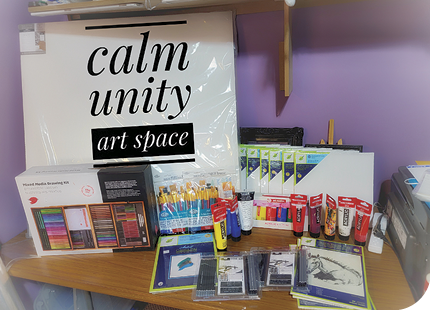
Concave Gallery, located in Code’s Mill in downtown Perth, recently opened their Calm Unity Art Space. This is a safe and open creator space for members of the community to come and explore their artistic side, or just hang out for some company and conversation.
Gallery owners are asking artists in the area to bring any gently-used or abandoned project materials into the gallery so that they can offer free art supplies to those who, for whatever reason, don’t have access to materials.
Get all the details by visiting Concave Gallery any time during regular business hours, or by finding them on Facebook.
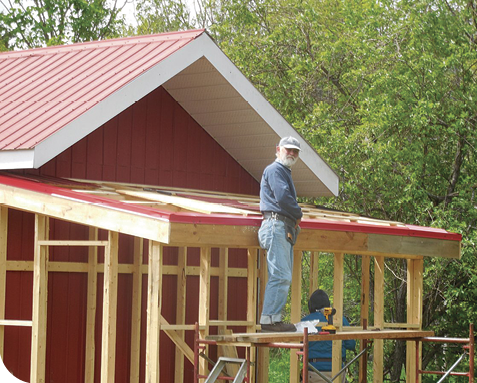
It’s rare to find a gentle soul as quiet, determined, smiling, capable and successful as the late Mike Macpherson. Mike could be defined as the consummate volunteer that any organization would be honoured to have on its roster. It’s little wonder that the Mississippi Madawaska Land Trust (MMLT) has chosen to dedicate the 2022 Birdhouse Bonanza Auction to his memory.
Mike was a founding member of the Land Trust board in 2003, supporting a favourite cause of preserving properties for posterity. Since that time, he has worked tirelessly to enhance many of the sites nature lovers can now enjoy. Whether it was fundraising, clearing brush, digging fence post holes or negotiating with authorities, Mike handled each task with a strong back and good humour. Even a rainy day would be declared a “Silver Day”, in Mike’s inimitable style.
He never backed down from a challenge when he knew the outcome would be worthwhile. He was instrumental in the innumerable City of Ottawa meetings to save the Carp Hills Easement, and not conceding defeat, he went on to reach an agreement with the landowner himself. Today the Carp Hills area has been preserved largely through his initial efforts.
Mike had a hand in many of the Land Trust acquisitions, but none was as special to him as High Lonesome Nature Reserve near Pakenham. Recognizing that visitors needed a meeting place, he organized a volunteer group to convert an old garage to a Welcome Centre, a cheerful introduction to the trail system and the features of High Lonesome. He would be delighted to know the proceeds of the auction are going to enhance that venue.
The MMLT was fortunate to have Mike’s expertise with tools and talk — both valuable assets to their organization for the many years he served as a key mover and shaker. He will be remembered for all his endeavours. His happiest times were spent wilderness camping with some of his family and friends, or leading groups of enthusiastic hikers along the trails, noting points of interest, butterflies, birds, whatever had caught his eye. Stopping at his memorial bench by the Beaver Pond at High Lonesome, visitors should take a moment to thank Mike for his constant dedication that has made it possible for so many others to enjoy his vision.

Humm headquarters got a frantic and flappy phone call recently from one of our favourite feathered friends. Jacob Bluejay wanted to tell us that he had brokered a special deal on Day Passes to the Puppets Up! International Puppet Festival <puppetsup.com>, scheduled for August 12–14 of this year. He was chirping so excitedly that we asked if we could email him some questions instead. Once we deciphered his chicken-scratching, this is what he had to say:
theHumm: Are the rumours true, Jacob? Is Puppets Up really coming back to Almonte this summer?
Jacob Bluejay: You heard it right, Hummsters. Just over a year ago, Noreen Young and Jane Torrance put a call out to the community, and over 70 people came forward to help bring the festival back. You might say they flocked to it! Since then they’ve been busily fluttering around organizing all of the… stuff that needs organizing!
Is it going to have all the same awesome “stuff” that past Puppets Ups were known for?
You bet! Puppets troupes extraordinaire are being invited — including some past favourites like the Frogtown Mountain Puppeteers, Tanglewood Marionettes and Joshua Holden, as well as new troupes and special guests. The amazing Puppets Up Parade returns on Saturday and Sunday, when there will also be plenty of street entertainment as well as a Kids’ Craft Tent where young folks can create their own puppets.
And what about the Friday program?
Friday is a quieter day, with shows in two of the five venues and a bit of street entertainment. It’s good for really young kids, and it’s also cheeper!
You mean less expensive?
Yep. That’s just how the word comes out when I type it. Weird.
Are there some special perks just for adults?
Are there ever! Not only will there be a Saturday night “exxxtra naughty puppet cabaret” (my terminology — I haven’t run that by Noreen yet), but word on the street is that the amazing Ronnie Burkett will be coming to town for a very special performance on Friday night!
That’s phenomenal! But it’s just the day passes that are on sale now, right?
Holy crow — isn’t that enough?!?
Of course! Sorry to ruffle your feathers there…
Not only that — the Early Bird Bluejay prices will save you loads of money! But there’s a limited number of Day Passes available at these low low prices, so act now! Head on over to Tickets Please and buy yours today!
I imagine it takes a lot of hard work — and money — to resurrect a festival, especially these days. Are there other ways that people can get involved?
There sure are. If you’d like to volunteer, either leading up to the festival or during the three-day extravaganza itself, you can email Kris Riendeau at <kris@thehumm.com> and she’ll add you to her growing list of awesome folks. You can also make a donation, or email <sponsorship@puppetsup.com> to find out about the terrific sponsorship opportunities that are available. So many ways to get involved!
One last question: why are all these people working so hard to bring Puppets Up back to town?
Well, I’m guessing it’s because of the warm fuzzy community feeling that we all got from the festival back in its heyday. So many friendly, smiling volunteers; so many amazing performances, so many happy kids and families. It seems to me that everyone just wants to have more of that in their lives. Either that, or they’re a bunch of birdbrains.…
Thanks for taking the time to share all this with us, Jacob.
No problemo. But now I gotta fly!
Buy your Puppets Up passes today at the discounted Early Bird Bluejay prices by visiting <ticketsplease.ca> or calling 485–6434!
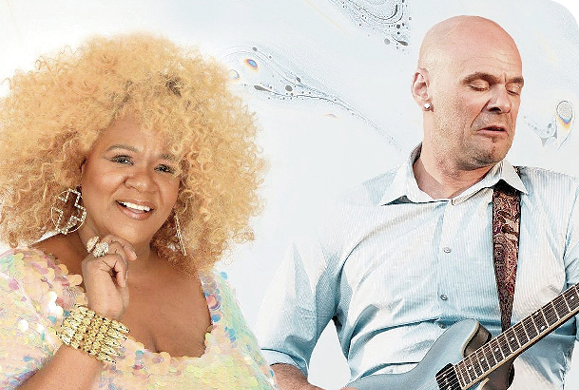
Great news — Blues On The Rideau is returning to The Cove in Westport this spring! With the pandemic slowly staring to ease and restrictions being lifted in Ontario, organizers are very pleased to announce that the Blues On The Rideau Dinner & Show fundraiser series will be bringing three dynamic blues bands to The Cove Inn this spring.
All shows include a delicious dinner, an evening of great live blues and some terrific door prizes, plus a chance to win a grand prize at the end of the series. Proceeds from all shows go to help local charities.
The Spring Series gets a kickstart on March 25 and 26 when Detroit’s ZOOM comes to town with Kitchener’s Shawn Kellerman Band. Born in Michigan, ZOOM started belting out her real deal Chicago blues in the ’90s, touring around the world with the likes of Bobby Rush, Sherman Robertson and Lucky Peterson. She took a two-decade hiatus to raise her family but now she’s back with a vengeance, backed by Shawn Kellerman’s ferocious funk blues guitar and dynamite band. If you’ve never heard of ZOOM, check her out at <zoombluesmusic.com>. Proceeds from this show go to St. Edward’s and Rideau Vista Elementary Schools.
On April 15 and 16, the Jack de Keyzer band <jackdekeyzer.com> will make the road trip up from Toronto to deliver dynamite blues, soul, funk and R&B to Westport. Arguably the most popular band to have played BOTR over the past 17 years, Jack always delivers a great show. Canada’s “king of the blues guitar” is a two-time Juno Award winner, seven-time Maple Blues Award winner, and International Songwriting Award winner. Proceeds will go to the Westport Food Bank and Westport in Bloom
Then on May 12 and 13, Kenny “Blues Boss” Wayne <kennybluesboss.com> comes all the way from Kelowna, BC. A monster piano player, imaginative songwriter and soulful singer in the style of Fats Domino, Johnnie Johnson and Ray Charles, Kenny is backed by a very tight band. Kenny is a Member of the Boogie-Woogie Piano Hall of Fame, has a Living Blues Magazine Award, a Juno Award and multiple Maple Blues Awards — and is the best dressed bluesman in Canada! Kenny is long overdue to return to BOTR — his last visit was in 2008. Proceeds from this show will go to the Rideau Waterway Land Trust and to Friends of Foley Mountain.
Each show is $80 per person (plus HST and gratuity), and all shows run from 7–11pm.
Advance reservations are required — email The Cove at <thecoveinnwestport@gmail.com> or call 273–3636. After two years of restrictions, people are champing at the bit to get out and enjoy some great live music again and there is still limited capacity, so book early!
Safety protocols are changing rapidly in Ontario. At present, proof of vaccination, wearing masks to enter and when moving around the room, 2-metre distancing between tables and a “no dancing” rule remain in effect, but restrictions are supposed to lift further on March 1. Please check with The Cove for updates.
Organizers also ask that you help to maximize safe seating for these shows by getting together with family and friends to book larger tables. There are only a few deuces available and they book up quickly.
Livestreaming Option
New this year — for those who can’t make it in person, BOTR will be doing livestreaming broadcasts of all shows in high quality HD video/audio on the Blues On The Rideau YouTube channel. Broadcast times for all shows is from 8:30–11pm. There is no charge to view these shows, but donations to help out the artists are gratefully appreciated. There will be a PayPal button on the channel page. Comments are also welcome during the show and some will be read out by the MC during the show.

On Saturday, March 12, Lanark County Warden John Fenik will attend a ribbon cutting ceremony at the Perth Town Hall (80 Gore St. E., Perth). Area residents are invited to attend the 11am opening of the local job office for the Ministry of Just Transition.
Of course, the Ministry of Just Transition doesn’t actually exist. In the 2019 election, Prime Minister Justin Trudeau promised to introduce a Just Transition Act, “ensuring that workers have access to the training and support they need to succeed in the new clean economy.”
It’s been nearly 3 years since that promise, and we haven’t seen any serious progress. Meanwhile, our communities are experiencing extreme climate impacts, a multi-year global pandemic, and a looming economic crisis. The fossil fuel era is ending, and people can’t keep waiting for help with the transition to clean jobs.
2021 was marked by extreme heat, fuelling one of the worst wildfire seasons on record. In BC, an atmospheric river caused deadly mudslides that destroyed hundreds of homes and took out entire highways. We’ve also had to navigate the escalating COVID-19 health crisis that’s overwhelmed our hospitals and emergency services.
In 2022 there’s no time to waste. That’s why we’re taking action together across Canada on March 12th, to put our vision for a Just Transition on full display.
In addition to County Warden Fenik, candidates for June’s provincial election will be attending.
This event is co-sponsored by Climate Network Lanark, 350.org, and The Council of Canadians.
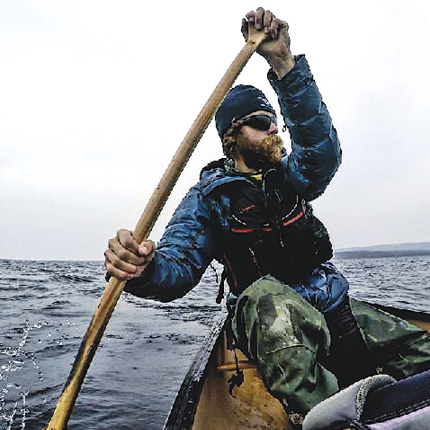
The Mississippi Madawaska Land Trust (MMLT) has invited well-known explorer, adventurer, conservationist and bestselling author Adam Shoalts to share stories of his expeditions in Canada’s wilderness with its members in association with its Annual General Meeting. Adam will talk about the importance of preserving wild places — from remote hinterlands to places closer to home.
Best known for his long solo canoe journeys, including crossing nearly 4,000km of Canada’s Arctic alone, Dr. Shoalts is the Westaway Explorer-in-Residence of the Royal Canadian Geographical Society and a regular guest on television and radio. His national bestselling books include Beyond the Trees: A Journey Alone Across Canada’s Arctic, A History of Canada in 10 Maps, and The Whisper on the Night Wind. A geographer, historian and archaeologist, Shoalts has a PhD in History from McMaster University. Learn more about him at <adamshoalts.com>.
The MMLT Annual General Meeting and Presentation will be held on the evening of March 23 via Zoom. For information about how to register for this and other MMLT events, visit <mmlt.ca/events> or call 253–2722. Not yet a member, or need to renew your membership? Please visit <mmlt.ca/product/mmlt-membership>.
I find it shocking to read reports revealing that as much as fifty percent of the food we grow is wasted. As someone deeply concerned about the level of food insecurity in our society, I find this level of waste totally incongruous in a country where one family in eight grapples with food insecurity.
Not only is this a bad news story vis-à-vis food security — there are also major negative effects for our climate emergency. The resources — water, fuel, chemicals and human effort — that are used to grow this food are wasted. But a much more insidious impact is what happens to those millions of tonnes of food waste that go to landfill. Food waste eventually breaks down and produces methane — a powerful greenhouse gas.
This seems to me to be such a “no-brainer” — let’s be better stewards of the food we produce; let’s direct more of it to those who need it; and let’s keep any waste food out of landfill. End result? Reduction in food insecurity and hunger and a reduction in greenhouse gas production.
So where in the food chain is all this food wasted? Estimates in various studies are all over the map — one surprising study calculated that almost half of the waste takes place in the home of consumers; waste on the farm is 10%; processing, transportation and distribution another 25%; and retail 10%.
Certainly one can quibble over definitions and methodology and what the actual percentage might be, but the inescapable truth is that a criminal amount of food waste takes place. Given my penchant for voraciously consuming detective novels, I decided to do a bit of sleuthing on the local level to grapple with who is guilty of all this waste.
I started my investigation by talking to local vegetable growers and a couple of food retailers in Mississippi Mills.
Vegetable farmers Scott and Marissa of Indian Creek Orchard Gardens commit to supply over 200 clients with a weekly veggie box. In order to guarantee this, they have to plant a fair number of extra plants to ensure the boxes will be full (given the vagaries of Mother Nature). So what do they do with any extra produce? Their first option is to sell it at the Almonte Farmers’ Market, their second is to donate to the Lanark County Food Bank, their third is to feed it to their chickens, and the final option is to compost it on their land. Bottom line? None of the food produced goes to landfill!
Sharon at Dandelion Foods states that produce that is approaching its “best before” date is marked down to half-price; if that strategy doesn’t work, a weekly donation is made to the Lanark County Food Bank; and produce that is too far gone is sent to a local farmer for his pigs. Basically, no produce goes to landfill!
Guido from Patrice’s Your Independent Grocer has a similar approach. Food that is close to its “best before” date is put on the fifty percent shelf, regular donations are made to the Food Bank, and the remaining food waste is directed to an in-house system (ORCA) that digests food waste into a liquid that is directed to the municipal waste treatment plant. Again, none of the food waste goes to landfill.
For its part, the Lanark County Food Bank is always happy to receive food donations. As you might imagine, donations are not always at the peak of quality. Expired products are discarded; however, this affects very few products — mainly baby formula and meal supplements (such as Boost or Ensure). Karen notes that “best before” dates are relatively arbitrary — Food Banks Canada advises that food can be handed out that is up to a year past its “best before” date. About two to three percent of all the food donated becomes food waste — it is donated to farmers to feed their pigs and goats.
I am led to conclude from this investigation that the perpetrators are you and me! As in any investigation, it is important try to find a motive. Perhaps we have a tendency to stockpile, take advantage of great bargains on a truckload of salad at Costco, not store food appropriately (pretty easy to freeze some), find it too much of a bother to donate to food banks, don’t take the time to sort food waste from other garbage, or just lose track of leftovers in the fridge.
My spouse and I, on a fairly regular basis, have a discussion over whether leftovers that have been carefully stored in plastic containers in the fridge pass the sniff test. Fortunately, her “sniffer” is much more sensitive than mine.
Many consumers are confused by best before dates and automatically toss food as it approaches that date. However, this only refers to the quality of the food when it will be at peak quality — food does not necessarily become unsafe after the best before date! Of course, this does not apply to perishable foods such as meats and dairy that must be eaten, refrigerated or frozen when you get home from the store.
Food waste does not belong in landfill — it will generate methane gas, which is one of the worst greenhouse gases. With few exceptions (such as meat and dairy), most waste food can be safely composted. If you are not comfortable composting yet, there is a lot of help out there — workshops, lectures or even YouTube videos!
If you don’t have a backyard with room for a compost bin, you might consider lobbying your landlord or your local municipal council to set up a composting program, or perhaps suggest sharing a composter with a friend who has a backyard.
Learn the basics of short form comedy writing (skits, sketches and short plays) with Rob and Kris Riendeau from Humm Team Productions. Rob wrote the script for Who Stole Christmas from Mississippi Mills and has since turned his attention to short form comedic writing. Kris is well known locally as the director of Who Stole Christmas…, Phantom of the Hubera, A Peak at Pakenham and Mosquito. Together they will guide participants through the process of coming up with funny premises (premisi? premisuses?…), fleshing them out with fun characters, and polishing them into brilliant little hilarious gems that you will be proud to show off to everyone you know!
This six-week workshop will take place at St. Andrew’s United Church in Pakenham and only costs $50 per participant. The course runs Tuesdays from 7–9pm, March 15 to April 19.
If you’ve ever watched Saturday Night Live and thought “that’s not funny!”, this is the course for you! Reserve your spot at Tickets Please (ticketsplease.ca or 485-6434) or contact Kris at <kris@thehumm.com> for more details.
The Olympics are over, the tears dried, and the best athletes have gone home without a medal. Is that what we could have expected? The Almonte Lecture on March 25 might offer some insight into that assumption. Warren Thorngate, Professor Emeritus of Psychology, has often delved into the machinations of the human psyche to discover anomalies we have not considered. His lecture, entitled “Why the Best Person Rarely Wins”, could offer some possible explanations for the conundrum known as the Olympics.
Warren Thorngate has presented several fascinating courses for Learning in Almonte, describing studies that showed behaviour quite at odds with our assumptions. Contests of all kinds often provide opportunities for extenuating circumstances to alter the outcome, regardless of how much effort the participants put forth. Thorngate has studied all sorts of contests, from elections to physical endeavours, and has discovered the sad truth that the best candidate often loses. His career was spent researching and teaching human decision making, problem solving and social motivation — all elements that have a profound effect on contest outcomes.
The Almonte Lecture will be presented online on March 25 at 7:30pm, and you can register at <almontelectures.net>. These monthly lectures have been successful thanks to the generosity of many donors. On the website you will find the Donate Button, and your contribution will ensure the continuation of these lectures. Nothing could be easier, and for sure participants at this lecture will all be winners!
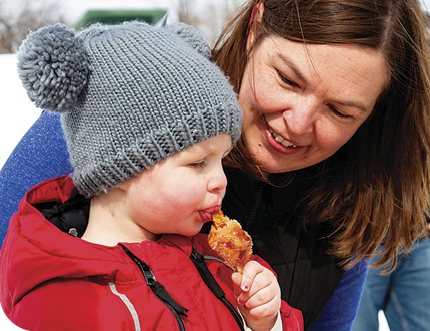
After a two-year hiatus due to the pandemic, the Lanark & District Maple Syrup Producers’ Association (LDMSPA) is very pleased to announce that Maple Weekend is returning on April 2 and 3.
“We are thrilled to be able to offer this fun, Canadian event once again this year,” says President Jamie Fortune. “After two years we are so excited to be able to welcome visitors to our sugar bushes again and celebrate the sweetest time of the year in Lanark & District.”
Maple Weekend is a fun two-day family-friendly event that celebrates Ontario’s maple heritage at participating sugarbushes across the province. This spring, the weather looks prime for record flows leading into April!
On April 2 and 3, Maple Weekend visitors to participating sugarbushes in Lanark & District can expect to experience the best of maple syrup season. Traditional maple syrup experiences may differ from farm to farm, but often include taffy on snow, pancake breakfasts, sugar making demonstrations, outdoor activities, and chatting one-on-one with the maple syrup producers who make this sweet liquid gold.
“We are counting the days until the sap starts flowing, and we’re already in the bush working hard to produce a bumper maple syrup crop again this year,” adds Fortune. “Maple Weekend is a great time to visit a sugar bush — this is when we really pull out all the stops to showcase the best maple experiences, from eating taffy to learning how maple syrup is made.”
Officially launched in 2015, Maple Weekend has been steadily growing each year. In 2017, Maple Weekend was nominated for Ontario Tourism Event of the Year, and in 2019 the event drew more than 15,000 visitors to maple sugar bushes across the province. The event was cancelled in 2020 and 2021 in order to prevent the spread of Covid-19 in our communities.
In 2022, there will be ten sugar bushes taking part in Maple Weekend in Lanark & District: Fortune Farms Sugar Bush, Fulton’s Sugar Bush and Maple Shop, Golden Moment Farm, Halladay Maple, Jameswood Maple, McEwen Acres, Oliver’s Mapleworks, Quabbin Hill Maple, Temple’s Sugar Bush and Thompsontown Maple Products.
Maple Weekend features two full days of activities and specials at participating maple syrup producers across the province. Running from 10am to 4pm both days, visitors can expect to enjoy tasting a new crop of maple syrup and getting an inside look on how this sweet liquid gold is produced.
Visit <mapleweekend.ca> for more information about what’s being offered at each location.

Oh no, here it comes again! That spring itch, the desire for something new, something not monochromatic, and something without the film that’s accumulated over the winter when the sun is low and the dust is disguised by dim lighting. Should we clean the house? Not yet, we could still be in the throes of winter. It can wait. Shall we start seedlings? Far too early when the snow is hiding the soil. Besides, you know full well you aren’t supposed to be buying seeds. Weeks to go, weeks to go.
March 1 rolls around quickly. We embrace St. David’s Day (the patron saint of Wales) by eating chocolate cake and singing Happy Birthday. Sometimes I make potato leek soup, leeks being the second favourite plant of Wales after daffodils. We don’t sing Men of Harlech to celebrate Alan’s birthday. After two years we’re still dining out on his 80th milestone when family came from far and wide.
March 1 seems like the beginning of the end of winter. The days get long enough that we don’t want the woodstove glowing at 4pm, but we still cocoon in the evenings. We also know it’s the beginning of the mud season, when the dogs can’t be out without the prospect of dunk baths for feet and tummies, a whole lot of work, a whole lot of shakin’ goin’ on when they get out of the tub. No use housecleaning while that’s happening!
Windows could use a vinegar wash where the dogs have wiped their noses all winter and now the sun is disgracing me. The first sunny day, I have to control myself not to yank down the curtains, haul out the squeegee and have at it. But I know there’s rain to come, and what’s the point before we’re done with that? Also, clean windows are a major bird crashing hazard, and wouldn’t that be a shame? The windows need to wait.
I notice how the baseboards and cupboard fronts have taken a beating over the winter, but that’s got to be the hardest job. I have to get down on hands and knees, and getting down is not a good idea unless I’ve set up a plan for getting back up! Further, painting is apparently a dog-friendly activity that needs their full participation. I think that’s going to get put off until they can go for a spa day.
In a quest for spring colour, I could change up my wardrobe. I have to get rid of the winter blahs and find something bright. Maybe I need a shopping trip, but that involves traipsing to a fitting room with mirrors, God forbid, and hauling off all the winter gear to try on something new. Far too much effort there, and besides that mirror adds pounds to my poor old body. I really don’t need to see that now. Back to the drawing board!
There is an antidote for the spring itch that involves outdoors, exercise, dreaming, looking, listening and waiting. I can spend hours watching the snow melt, measuring its decline, smashing up the ice edges on the driveway, seeing the buds swelling on the maple trees. One day there will be red maple buds, then yellow willow branches, then soft furry sumac bark. One day there’ll be drip, drip from the eavestrough. One day the chickadees will start their spring songs, and then one day the glorious cheep of a robin or a cardinal. “Pretty, pretty, pretty”. Oh yes, the cardinal has that right!
Once I get outside, the spring itch isn’t so severe, and I can spend (never waste!) hours grasping at every spring straw that comes my way. Sitting in the weak sun of late March can lull me into garden dreams. There might be a crocus just then poking up through the snow where the early melt is revealing the edge of what will be a flower bed in two months. I might be tempted to clear away a little more snow that covers it, but I resist for fear I will destroy it.
What I really crave is birch leaf green, apple tree green; forget-me-not blue, hyacinth blue; daffodil yellow, dandelion yellow. I want the pond ice to melt, I want the grass to grow, I want to be outside for the next six months, unhampered by bugs, sunburn and weeds. That’s a fantasy of course, but it’s a good salve to a spring itch.
Every season is beautiful in its own way, and as one season drifts into another we are always waiting for the next big thing. I can easily sweep March Madness under the nearest carpet. But this defence is absurd. No Housework Fairy is coming any time soon, so one day I’ll have to grab the duster and the paintbrush. The idea is to reward myself with a shopping day if I get it done in a week. Further, if I do a really good job, I’ll buy a few seed packets, only enough to fill every plastic container I’ve saved all winter. Maybe this’ll be the antidote I needed all along.
Spring, wait for me. I’m nearly done with March Madness!
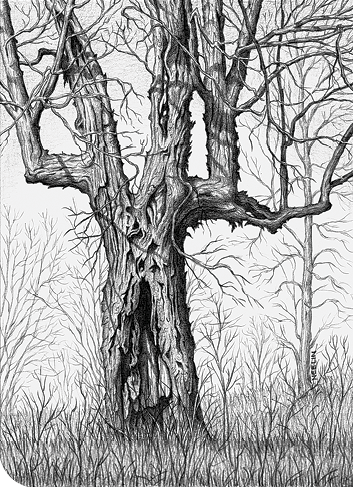
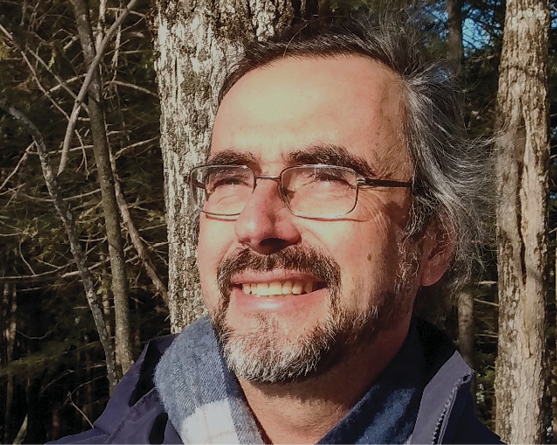
Art… and Soul
When you can’t decide which you enjoy more — creating your art or doing your job — you’ve made some exceptionally wise decisions in your life. Residential designer and illustrator Michael Neelin of McDonalds Corners would be hard pressed to pick between the two. Neelin capitalizes on his exceptional drawing abilities in both pursuits, and both tie in with his passion for sharing the natural beauty and rich architectural heritage of the Ottawa Valley.
As a gifted artist, Neelin celebrates his deep appreciation for the artistic gifts that surround us. His pencil drawings are heartfelt reminders of the rewards to be found if we expand our capacity to look and see. He uses a standard 4B lead pencil because he prefers to work in black and white. It enables the viewer to see things in a different way; colour has a tendency to obscure certain details, like shadows and textures. One look at his compelling drawings of gnarly roots, funky rock faces, or a venerable tree skeleton, proves his point.
His black and white portraits of tumbling down farmsteads and “farmscapes” are testimonials to his love of heritage buildings, as are his drawings of the heritage buildings in Almonte and other Valley townships. He traces his entire life’s work, both as an artist and a designer of houses, to an epiphany he experienced when he was thirteen years old and fortunate to spend a year in Alsace, France. His lifelong passion for drawing is a result of “falling in love with sketching historic architecture in the streets and alleys at the foot of Strasbourg Cathedral and visiting dozens of ruined castles on the slopes of the Vosges Mountains nearby.”
Michael started drawing when he was one year old and has never stopped. He remembers challenging himself to sketch the heritage castles in France in the same amount of time it took his dad to set up his old Leica camera with a handheld light metre and take a photo. Today he does rapid plein air sketches as he wanders and paddles in the backwoods, always looking for landscapes that bring him joy that he can share with others. He also does magnificent, detailed portraits — his recent pencil rendering of Strasbourg Cathedral, done as a nostalgic gesture from a photo taken long ago, is stunning.
Raised in the Glebe in Ottawa, Neelin earned his B.A. in History of Art and Architecture at Carleton University, where his dad was a professor of Biochemistry. An accredited architectural technologist, he is now president of his own residential design firm, RiverSong. He has designed over 300 custom handcrafted homes and renovations as an independent professional since 1984. His daughter Genevieve joined his practice in 2014.
After six years directing a summer camp in the Upper Gatineau where he met his wife Lyndal as a teen, the couple eventually settled in Pontiac County, Quebec, and raised four daughters there. Michael established himself as a member of the Pontiac arts community; he was a member of the Pontiac Artists’ Association, a board member, and participated in the Pontiac Artists’ Studio Tour for many years. He even recalls that they advertised their studio tours in theHumm. He still remembers the thrill of his first artist studio tour, and how much he enjoyed inviting the public into the family home to share his work and his inspirations. He couldn’t decide which he would give up — architecture, where he worked with people and helped them realize their dreams, or art. So he has arranged his life to be able to do both.
Throughout his childhood he was a camper and cottager with his family on a fourteen-acre piece of waterfront property on Patterson Lake, three kilometres from McDonalds Corners. When the couple inherited part of the property, they decided to build a home there; it was finished eight years ago. Lyndal has been very involved at MERA Schoolhouse, including past Chair of the Board, and Michael’s art will be on display there throughout the month of March in a solo art show at Dean Hall. The Schoolhouse is located at 974 Dalhousie Concession 9A in McDonalds Corners <meraschoolhouse.org>.
It is a true pleasure to open your eyes and share this artist’s enjoyment and celebration of the natural beauty and rich architectural heritage that surrounds us in the Ottawa Valley. You can do just that and meet Michael at the “Meet the Artist” event on Sunday, March 13 from 2–4pm. To see his exhibition at other times, it is necessary to make an appointment; details are on the back of his Artist Trading Card.
Another opportunity to enjoy his art is imminent. Michael’s daughter Gwendolyn Neelin is the proprietor and chef at Tea and Cake Catering in Almonte. As soon as her new location is open at 19 Bridge Street, you can enjoy Michael’s drawings while you enjoy Gwen’s renowned butterscotch pie (see the November 2017 issue of theHumm online for delicious details).
Radon Gas Warning
With Michael’s concurrence, we want to bring an important health issue to your attention. In 2020, while being treated for appendicitis, he was diagnosed with lung cancer. He has never smoked and has led an active outdoors life coupled with adherence to a healthy diet. It came as a surprise to me when he told me that that exposure to radon gas is the number one cause of lung cancer in non-smokers. According to Health Canada, 16% of lung cancers are estimated to be from radon exposure, resulting in more than 3,000 lung cancer deaths in Canada each year.
Radon is a radioactive gas that comes from uranium in the ground which can get into your home undetected. You can’t see it, smell it or taste it. In confined spaces like a house, radon can build up to high levels and over time become a health risk. The health risk from radon is long-term, not immediate. All homes have some level of radon. The question is how much and the only way to know is to test, at a small cost of around $40. The Neelins recommend that you do so.
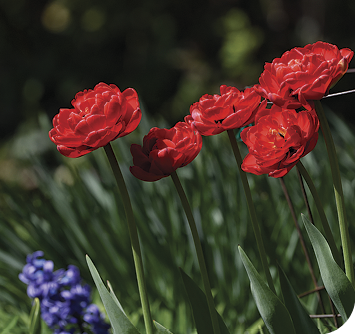
The Mississippi Valley Textile Museum (MVTM) is pleased to announce that this spring it will be starting a dye garden, located at the Blakeney Project farm site. The museum is very grateful to the Blakeney Project for the allocation of 1000 square feet of land and access to structural facilities for the garden.
The dye garden project connects with the history of the area, as the textile mills of the Mississippi Valley often had dye houses, however using chemical dyes. The wastewater from the chemical dyeing process ended up in the river daily, creating toxic conditions for wildlife and residents. The natural dye garden will address contemporary interest in natural dyeing processes and environmental conservation, and will create exciting opportunities for education and activities for residents.
Organizers are currently looking for volunteers: if you have experience growing plants from seed, enjoy gardening, weeding, have textile skills or any other skills to offer (you don’t need to have a green thumb!), please email Melanie at <m.girdwood@mvtm.ca>. This is a wonderful opportunity to volunteer and get active outdoors, for folks of any age!

March is the month where winter gets to feeling a little long. We know the light is coming, but it’s getting hard to hold on. It’s the month where something a little soulful, a little tender and a little blue fits the bill. On March 26, we are very lucky to bring two talented artists to the Folkus stage who have spent years on their overnight success.
Julian Taylor is a songwriter at the top of his game, garnering a recent CFMA Solo Artist of the year, and a Polaris Prize nomination for 2021. This year, Taylor was nominated for five 2022 Native American Music Awards, including Best Début Artist (!), Country Recording, Folk Recording, Male Vocalist, and Country Video. The Ridge, his latest recording, is a tender and heartfelt exploration of childhood and family that finds the artist at his most reflective. Taylor is an artist who isn’t bound by genre, but this latest recording takes us back to his roots, evoking his childhood soundtrack of Lightfoot, The Band, and his grandfather’s classic country records, while being true to his own path as leader of multiple bands.
Of West Indian and Mohawk descent, Taylor first made his name as frontman of Staggered Crossing in the early 2000s. These days, however, the soulful singer/guitarist might be on stage one night playing with his eponymous band, spilling out electrified rhythm and blues glory, and the next he is at a folk festival delivering a captivating solo singer-songwriter set. In everything he does, Taylor has carved his own path, creating genre-free music with a generosity of spirit and a strong belief in the healing powers of song. We are lucky to have him for such an intimate performance.
As Jim Cuddy of Blue Rodeo puts it: “In these times, we could use a little heart and soul, and Julian Taylor’s latest is all heart and soul. Warm wrap-around-you sounds with that velvety voice. A very beautiful record.”
Catriona Sturton is a multi-instrumentalist tour de force, bringing a sometimes tender, sometimes comic sensibility to her songs about mysteries, the blues, cats and late-night calls. Friends of Folkus might have been lucky enough to catch her set at our fall presentation at the Art Romp.
Sturton has had a long apprenticeship in music. After learning to file harmonica reeds in a back alley (she studied under Larry “The Bird” Mootham), Catriona became the bassist for Halifax teen-rockers Plumtree (who inspired the cult-favourite book and movie, Scott Pilgrim, with their song of the same name). She later moved to Japan where she formed a garage band, and then circled back to Ottawa. She plays harmonica, guitar, bass and fiddle, sometimes all at the same time.
Her biggest claim to fame might be that she “…may have written the best song to date about butt-dialing — Calling from My Pants”, according to Critics Pick, Nashville Scene.
Tickets, both in-person and streaming, are available through our ticketing partner Tickets Please (ticketsplease.ca/folkus or 485–6434). All shows are at the Almonte Old Town Hall, and doors open at 7:15 this year; show time is 8pm. Please check our website for updates about safety protocols, the availability of fine beverages, and other news at <folkusalmonte.com>.
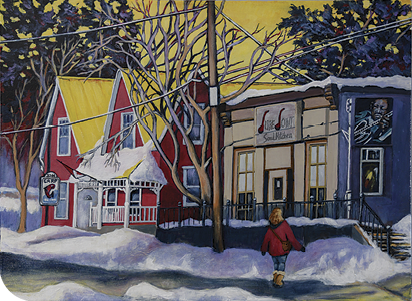
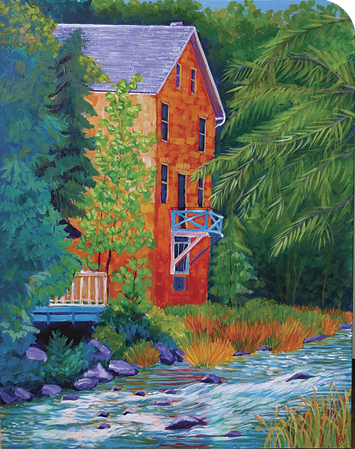
Spring is the season of creation, and to celebrate, West Carleton Arts Society (WCAS) is once again presenting its Spring Fling Art Show at the Kanata Civic Art Gallery, located at 2500 Campeau Road.
Taking place from March 7–20, this year’s show will feature works by 27 talented local artists in a variety of media. “This is always a fun show,” says Anne Moore, WCAS Shows Director. “We have watercolour, oil and acrylic paintings, as well as photography and mixed media works. We will be presenting 63 impressive works of juried art, which can be viewed and purchased at the show.”
A three-member jury, independent of WCAS, reviewed all submissions and provided scoring results which determined entrance into the show. “We are thrilled that we can once again have a physical show at the Kanata Civic Art Gallery,” Moore adds. “It’s a great opportunity to view these amazing artworks and support local artists.”
Established in 1988, the West Carleton Arts Society is an active, non-profit volunteer organization of vibrant, talented visual artists and fine crafts people. Its dynamic program includes regular ARTiculate artists’ presentations, an annual Spring Into Art Conference, the fall Expressions of Art show and sale, and the $100 & Under Christmas sale. Member benefits also include opportunities to show work at several local venues and to engage with other regional artists.
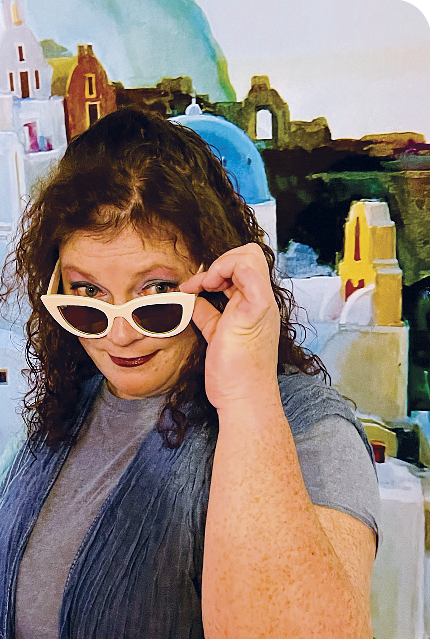
Putting on plays while a pandemic rages has its challenges, but Studio Theatre Perth is once again rising to that challenge and is proud to present Shirley Valentine by Willy Russell, opening in late March.
Often described as a “chick play”, Shirley Valentine is so much more than that, according to Jane Stott, Studio Theatre Perth’s artistic director and the director of this play.
“It’s really a play for everyone. A lot of the things that Shirley Valentine talks about affect both men and women; a lot of the issues she raises are relevant to anyone who has worked, raised children and wondered where they lost themselves,” says Stott.
In typical Willy Russell fashion, the play is edgy, funny, sad, troubling in a good way, and resolved with a happy, if open-ended, conclusion.
This play is a one-woman show, with veteran actor Krista Duff taking on the role of Shirley. According to Stott, Duff capably introduces and portrays the many characters in Shirley’s life with believable compassion, grit and humour.
“There are so many characters that Shirley brings onto the stage and shares with the audience, and that can’t happen unless you have a great actor like Krista,” explains Stott. “This is a play that involves the audience, drawing them in and engaging their participation.”
Known to focus heavily on character development as a director, Stott has found a kindred spirit in Duff. Both women see the play and the character of Shirley in the same light.
“It’s a play about liking yourself and falling back in love with yourself — learning to love life again,” says Duff.
Both Stott and Duff love the ambiguous ending and are guarding its mystery.
“Nobody knows at the end if Shirley and Joe will get back together — the audience can decide for themselves”, hints Stott. “In my head, Shirley stays in Greece, so if they get back together then Joe stays with her,” adds Duff.
Because of pandemic restrictions and safety protocols, the play is currently being rehearsed over Zoom. It’s more doable with a one-woman show than perhaps a production with multiple characters, but it’s still far from ideal.
“I’ll be glad to get to the theatre to block the play,” says Stott. “We’ve started blocking [moving the actor around the stage], but once we get into the theatre then we can really start working on projection and movement.”
Set in Shirley’s kitchen in Liverpool in Act I and then moving to Greece in Act II, this is the kind of play that’s filled with the humour, pathos and familiar ups and downs of a middle-class life lived within societal norms — and the courage it takes to break away from those norms.
Shirley Valentine opens on March 31 and runs April 1, 2, 7, 8 and 9 at 7:30pm and April 3 and 10 at 2pm at Studio Theatre Perth on Gore Street. Tickets are $24 and can be purchased at <ticketsplease.ca> or by calling 485–6434. They are also available at the door. For more information, please visit <studiotheatreperth.com>.
This production of Shirley Valentine is sponsored by Déjà Vu Hair Salon, Gore Street, Perth.
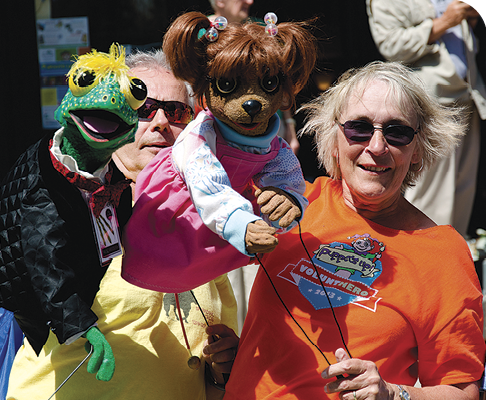
Where did you first encounter a puppet, or better yet, when did a puppet first find you?
Time’s right to consider these burning questions as anticipation is growing for the 2022 Puppets Up! International Puppet Festival scheduled for the balmy days of August 12–14 in Almonte. Pay close attention to the growing burble in that community — you’ll pick up quickly on those energetic volunteers who are busily planning, producing, fundraising and fun-raising, all in the name of exceptional community engagement with fabricated folk!
And as if that alone wasn’t enough to drop your mittens and whirl them in the air, World Puppetry Day is on March 21 — yep, it’s a thing! The day was originally proposed by a puppet theatre artist from Iran, and first celebrated in 2003 through the Union Internationale de la Marionnette, a non-governmental organization affiliated with UNESCO to promote this global artform. Think about puppets that day why don’t you, and how traditions are renewed and become part of our lives.
For me, growing up in Montreal meant spending early days entranced by Bobino et Bobinette, Chez Hélène, The Friendly Giant, and once in a while, Kukla, Fran and Ollie beaming in from the US of A in beautiful black and white. Those mysterious beings opened a child’s eyes to the magic in the world, the artistry that can make it happen and the wisdom they often shared.
The ghosts of a childhood? Maybe. But then fast forward to a career working with NGOs and funding agencies, where sometimes puppetry was a creative way to conduct community outreach on issues such as immunizations, HIV/AIDS, mental health and rights. I keenly remember, especially now on a cold winter’s day, sitting on grass under starry skies in Indonesia framed by palm trees, watching shadow puppets stride across linen screens to the beat of Gamelan musicians — entertaining yes, but really a window into how cultural traditions are shared, and behavioural norms taught and encouraged.
Then there’s Almonte where, after a hiatus since 2016, the enchantments and excitement of Puppets Up! is returning precisely at a time when we’re needing community most. Streets will be filled once again with those pesky, pleasing, prominent puppets and their attendant folk.
Puppetry has a long pedigree and is diverse in presentation — marionettes on strings and rods, hand puppets, shadow figures and puppets manipulated or inhabited in full view. They have a way of suspending disbelief, if only for a time, and take us into another realm — that of a puppet-people universe. “A puppet can be as simple as your own bare hand or as complicated and mechanized as you can make it,” says Noreen Young, the creative force behind Puppets Up. “And best of all, a puppet can say things that you can’t say as yourself!”
I delved into that rarefied puppet space through the online World Encyclopedia of Puppetry Arts, created to ensure that our collective memory of puppetry arts is preserved as an evolving, shared human tradition. You’ll even find mention of a few folk familiar to Mississippi Mills, such as Noreen: “From a very young age, I’ve been attracted to the art of puppetry. It’s a form of theatre that includes so many different art disciplines — sculpture, painting, costuming, voicing, performing, writing, set design, costume design, production — and I love to do all those things!! It’s an art form that allows you to create characters from your imagination that are not only animal and human, but vegetable and objects — all ‘things’ that you can speak through.”
Puppets share their lives with characters of all types — basements are often filled with a cavalcade of personalities like the ones in the workshop of the multi-talented Ingrid Hamster, who clearly agrees with Noreen. Right now, Ingrid has a “focus on costumes for Sherlock Holmes and the Hound of the Basketballs”. Now that’s a great title for a riotous, bawdy pre-festival play to be presented in May. “The challenge is not to get too close, or start talking, to the 22 puppets in my studio,” Ingrid explains, “because the new 1890’s costumes bring these puppets back to life!” Hmmm, not sure, but I think Ingrid has a special relationship with a few of those characters springing into life.
As Noreen puts it: “Puppets are essentially communication tools. They speak to young people as well as old people. They speak to the child in all of us. They’re often used to educate. Through the ages they have represented the common man. They’re great for political satire and social commentary and they can be totally subversive.” Her work to engage children on such crucial issues as safety, nutrition, environmental awareness and addictions had Noreen invested as a Member of the Order of Canada in 1995. Interestingly, this year’s Puppets Up! will also feature Ronnie Burkett, another Canadian who has similarly been awarded by this nation, and Bernd Ogrodnik from Iceland, who was knighted with the Order of the Falcon for his work.
So, the question bears repeating: when did a puppet first see you? Support the puppets in all their diversity this summer, renew a community tradition, and celebrate magic yet again on the streets of Almonte — get ready for the festival!
Why wait for summer? Keep an eye on <puppetsup.com>, where you can already purchase day passes for this year’s festival at fabulous Early Bird Bluejay prices, as well as tickets for pre-festival events!
April Shows for Kids
At the Mississippi Valley Textile Museum:
April 2 — Pirate Treasure
April 9 — Punch and Judy: The Silly Version
April 23 — Felicity Falls
And One for the Adults:
Sherlock Holmes and the Hound of the Basketballs, on May 12, 13 & 14 at the Almonte Old Town Hall
And remember, puppets need you — help make the magic happen!
Donate at <gofundme.com/f/help-bring-the-puppets-back-to-almonte>
Become a sponsor — email for details: <sponsorship@puppetsup.com>
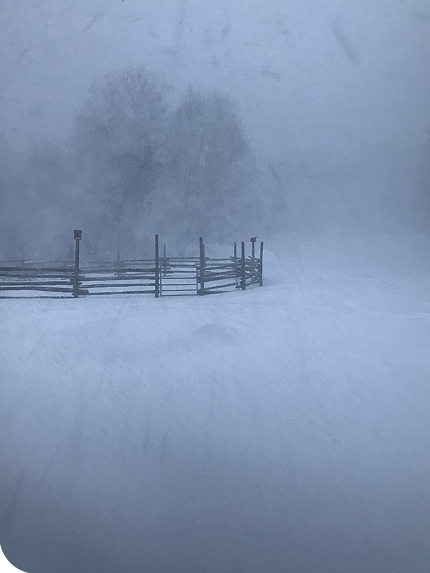
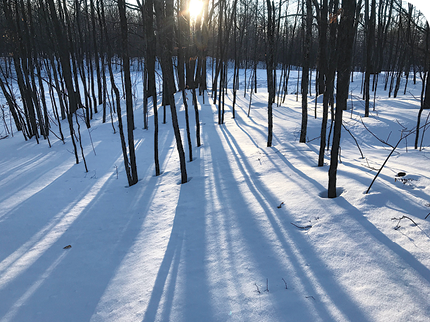
The snow has closed 123 kilometres of highway between Sharbot Lake and Ottawa. To my knowledge this has not happened in the 21 years I’ve lived here. Looking out my window, the snow spirits swirl like dervishes — dancing and twisting wildness around the house. Old Man Winter rattles the thin glass panes that safeguard me with the slimmest of barriers. He interrupts cushion-covered coziness; calling for Fear to attend to him. I note the impulses that arise — to check my phone, pour a glass of wine, rustle up a bit of chocolate, conjure up some online ‘surfing’, text a friend. To tread the well-worn paths to my escape hatches.
Tenacity and Fortitude are good winter companions here, if you can locate them. But my fickle friends Distraction and Aversion continue to ply me with varying degrees of material and psychic protection. I am beginning to realize these old pals may not be the best company for me to be keeping — their sugar-coated treats dissolve quickly. The realization pokes a few holes in the worn-out, rusting armour I’ve noticed myself trapped within. Peering through the perforations, I wonder at the soft belly of my own permeability.
A day later I venture out into the still, sun-shined woods, immediately breathless with the labour of walking, even with snowshoes, in deep snow. I’m breathless too beholding the beautiful animacy of snow puffing up bundles of sparkles from under my snowshoes with each footfall. Sun sparkles shimmy any remaining vapours of anxiety away. Beauty offers herself to my posse of pals.
In winter I think often about the other beings with whom I share this land: the deer and the coyotes who may struggle harder in deep snow to find the nourishment they need. The trees, stoically rooted in the frozen ground, taking any punches that come: wind, erratic waves of shifting temperatures, the weight of snow and ice on branches. Mice and voles, who may in fact be happy to have the thick, soft snow insulation to tunnel around under — out of sight of predators. The hawks who are feeling the effects of this; some of whom are wasting away as a result. And then there are the bears wrapped in their thick fur coats, dreaming away the winter in a dugout somewhere on the land. All of these beings, in spite of their vulnerabilities, accepting their lot with a grace I have not cultivated. They belong here. Do I? They know, and embody, their place. They are made, quite literally, from it and are, in turn, a vital part of its matrix. What place am I made from, and woven into?
The swans on the Tay River near here float out the cold, their serpentine necks twisting back to bury black-billed heads under their wings. It’s minus 28°C! They have been living for weeks on frigid water with the poise of… well… swans. How do they do it? Why aren’t they, or any other winged creature for that matter, many hundreds of miles south where the living would presumably be much easier? Their equanimity in the face of what, to me, seems like a large dose of adversity is a feat fit for the Zen Olympics. I, on the other hand, feel anything but swan-like in these deep-freeze weeks — bumbling along in my dumpling-down parka and snow-pant silhouette. In fact, what dawns on me is the somewhat frightful realization that I am rather more like a cow than a swan — so thoroughly domesticated and reliant on systems, supplies and supports from anywhere but here. I’d like to believe otherwise. I’d also like to believe that my life here is in some way “sustainable”. But it truly is not. The illusion, even the aspiration, of living here sustainably through winter has been nothing short of a happy fantasy. I can either weep or laugh. Or maybe I can do both. I see Humour and Humility off in the distance and beckon for them to join my posse.
What does it mean to belong? To be…long..in place? Can we imagine ourselves ever becoming truly integral to place? Maybe we need a new word — inplace. To inplace ourselves. To become inplaced. Perhaps it would give us an intention to orient ourselves around. Indigenous Peoples around the world know a thing or two about this. The Anishinaabe thrived here, where I now live, for centuries — adapting to harsh and taxing conditions with abundant wisdom, humility, and culture interwoven with the ecologies of life. Living without desecrating the land, requiring a beach vacation, cottages or fossil fuels. There is profound wisdom in this to awaken to.
The jesters are provoking us — skewering more holes through that old, tired armour made for other times and places; dismantling, with steadfast persistence, our misguided collective Hubris and bidding Humility to seep up through the rubble.
Another month passes. It is now mid-February. This morning as I step outside, it’s the smell and touch of wetness that meets my skin. Water falls in small raindrop skins, landing on a driveway sealed in a coat of slick ice. My grippers clack and slide me to the barn. The untrodden areas of puffy white snow next to the paths are collapsing like a ruined snow soufflé. Small clouds of mist lift off the surface of the melting pond. Water shapeshifts everywhere around me. In the slate cloud heavens above the land; in the willow that is beginning to blush her sap spring yellow; in the sea of invisible wet air in which all the visibles are swimming. I meet glints and trickles of watery genius in the folds of the land, and let myself steep for a while in her fluid ease. Owl watches over. The siskins feed. The stream sounds slide by. The hold of winter is softening in my heart. Amen! And my sweet, burgeoning fold of friends welcomes Love to the party.